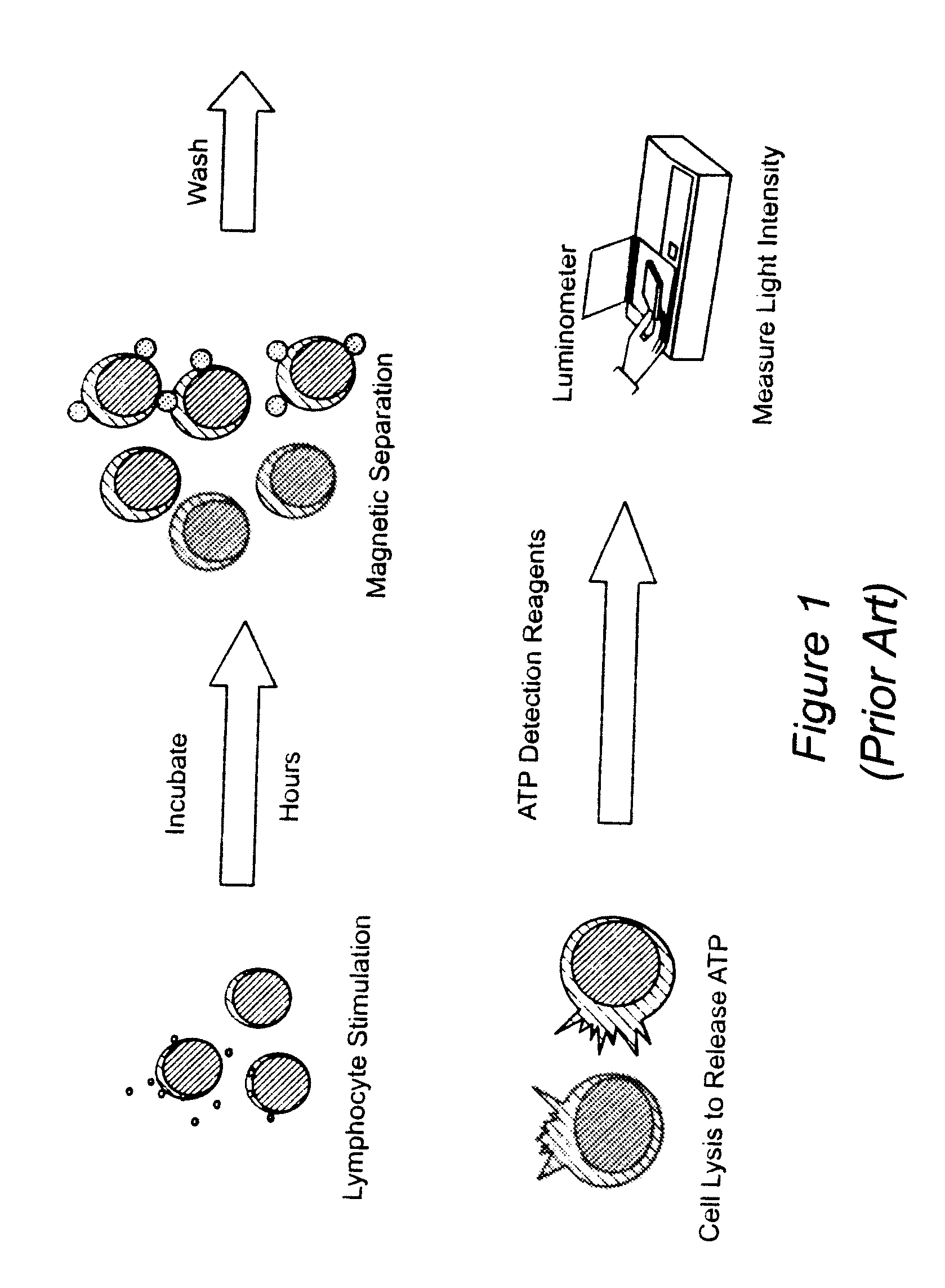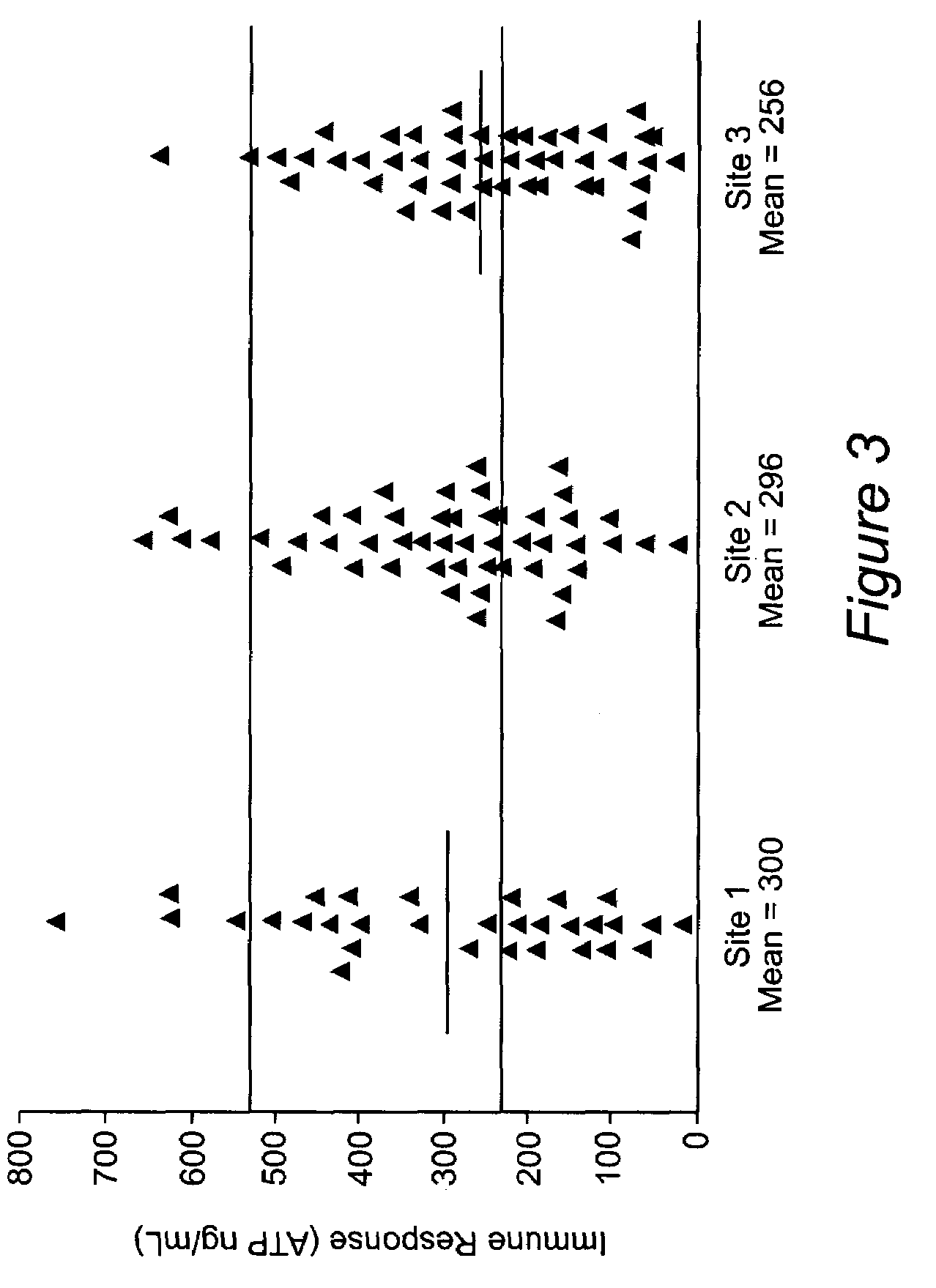Method for monitoring the immune response and predicting clinical outcomes in transplant recipients
a technology for monitoring the immune response and predicting clinical outcomes, applied in the direction of instruments, biochemistry apparatus and processes, material analysis, etc., can solve the problems of shortened graft survival and no direct assessment of immune status in transplant recipients
- Summary
- Abstract
- Description
- Claims
- Application Information
AI Technical Summary
Problems solved by technology
Method used
Image
Examples
example 1
Cylex™ Immune Cell Function Assay (ImmuKnow™): Principle of the Assay
[0048]Successful management of the transplant recipient currently requires lifelong immunosuppression of the patient to avoid graft rejection13. While calcineurin inhibitors have dramatically improved graft survival, the patient is at increased risk of drug toxicity, opportunistic infections and cancer14. Managing the relatively narrow therapeutic range of these drugs remains one of the challenges of transplant medicine. While tests for the trough levels of the major transplant drugs are routinely performed for patient monitoring, their main value is the avoidance of toxicity and assessing patient compliance15. Prior to the present invention, no test existed which directly measured the bioactivity of these drugs in the patient at any point in time. The methods of the present invention were designed specifically to assess the immune response in patients receiving immunosuppressive drugs.
[0049]The immunosuppressive t...
example 2
Statistical Characterization of the Immune Response Levels of Healthy Adults and Immunosuppressed Populations
[0058]A population-based study was conducted comparing the immune response characteristics of apparently healthy adult controls and recipients of solid organ transplants. As shown in FIG. 2, the apparently healthy control population (n=155) gave a stimulation response on average of 432 ng / mL ATP. The immune response characteristics of transplant recipients (n=127) were significantly statistically lower (P225 but <525), or strong (≧525). Also shown is the distribution of viral-induced immunosuppressed HIV patients. This immunosuppressed population was statistically similar to transplant recipients with an average immune response of 287 ng / mL ATP.
[0059]Most immunosuppressive drugs are currently administered on the basis of body weight13. Yet it is clear that the baseline levels of immune response in patients awaiting transplant vary enormously. Today, no method is available for...
example 3
Site-to-Site Comparison
[0061]A study was undertaken to ascertain the consistency results obtained using the methods of the present invention at several different clinical centers. The distributions in FIG. 3 show that there are no significant differences in patient immune responses at each of the three clinical centers. Site 1 (n=31) had a mean transplant patient immune response of 300 ng / mL ATP which was not statistically different from site 2 (n=49) or site 3 (n=47) with mean immune response values of 296 and 256 ng / mL ATP respectively.
[0062]The mean immune response at two of the three sites falls within the moderate zone. The population of patients at Site 3, which included a larger number of liver transplants, fell slightly below the moderate zone, consistent with the greater net immunosuppression in these patients resulting from the aggregate effects of more traumatic surgery and lower biological functioning.
[0063]Despite differences in populations, therapeutic protocols, and t...
PUM
| Property | Measurement | Unit |
|---|---|---|
| body weight | aaaaa | aaaaa |
| incubation time | aaaaa | aaaaa |
| time | aaaaa | aaaaa |
Abstract
Description
Claims
Application Information
 Login to View More
Login to View More - R&D
- Intellectual Property
- Life Sciences
- Materials
- Tech Scout
- Unparalleled Data Quality
- Higher Quality Content
- 60% Fewer Hallucinations
Browse by: Latest US Patents, China's latest patents, Technical Efficacy Thesaurus, Application Domain, Technology Topic, Popular Technical Reports.
© 2025 PatSnap. All rights reserved.Legal|Privacy policy|Modern Slavery Act Transparency Statement|Sitemap|About US| Contact US: help@patsnap.com



